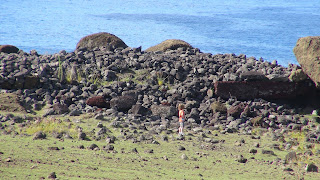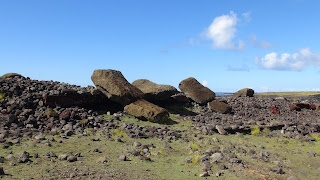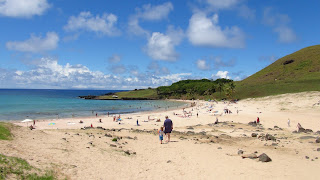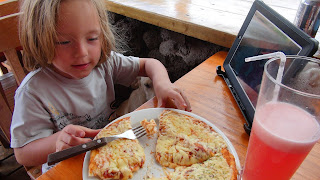Prior to this trip, I couldn't have pointed to Easter Island on the globe. I knew it was part of Chile (from a Chilean folkloric dinner show we attended on a mid-90s visit to Santiago, half of which was Polynesian dancing, to my great surprise), and I knew it was quite a ways from the coast of South America, but I didn't really know much more about it than that.
When we planned this trip, we wanted to visit favorite places as well as new ones, and Easter Island was on the list of places that sounded very interesting to see. My mental image was of a semi-barren, sort of gloomily beautiful island, not unlike the Azores, but much more sparsely populated. I knew the big thing to do was to go see the giant head statues, which I'd always heard were shrouded in mystery. We planned to spend five nights there, which I worried might be a bit much. After all, we'd go out and look at the statues in a day, probably, and then what?
The actual experience was incredibly different from what I imagined to would be, and so, so much better. There is basically one town on the island, Hanga Roa, and it is quite small. The remarkable thing about Easter Island (or Rapa Nui, as it is called in the language of its original inhabitants), is that that's actually all there is. It's not so far from Tahiti, but yet, it's a world away. There are no resorts, no high rises, and no distinct barrier between where the locals and tourists spend their time. When you go to Easter Island, you pretty much immerse yourself in the local culture, and that's such a rare experience these days.
Most of the hotels are small family-run places with a handful of rooms. There is no air conditioning, and there's such a constant breeze that, even though it was definitely hot and muggy, we didn't need it. There was no television in the room, no pool, and barely-functional internet service. I only rarely even got bars on my phone, even when I was standing next to the cell tower. In short, there was nothing to distract us from the experience of living on this island for five days.
And so on the second or third day, I found myself walking back from the island's single laundromat (conveniently close to our hotel), flip-flops smacking the brick sidewalk, and enjoying that cool breeze. A teenaged boy riding bareback trotted by, and then a scooter with a young couple and their toddler. People were sitting in the shade outside the sparsely-supplied grocery store (lots of beer but no milk!), talking and laughing. A couple of sunburned tourists passed me, on their way up the hill. I'd just had a brief conversation with a 12-year-old kid at the laundromat (all businesses here are family businesses), and had been pleased with my gradually increasing grasp on Chilean Spanish. And I suddenly thought, wow -- I feel like I'm just about as far from home as I can get.
We spent three of our five days touring the island with our private guide, an Aussie ex-pat named Larry. Larry first came to Rapa Nui twenty years ago when he was building sets for the eponymously named non-hit movie of Kevin Costner's. He met a Rapa Nui woman, fell in love, and ended up staying on the island. He had a fantastic knowledge of the culture, history, and archaeology, and we learned a great deal from him. I can't even begin to summarized all of the things he taught us; check out the film Rapa Nui or google for more information.
On the first day of our tour, we drove around the perimeter of the eastern half of the island. The coastline is littered with ahu, the large stone platforms on which the Rapa Nui people erected their moai, the famous statues that paid tribute to their ancestors. Most of the moai were pushed over by the Rapa Nui people not long after the arrival of Europeans (and the disease and cultural destruction they always brought with them); their faith was so profoundly shaken that they destroyed their own places of worship. Most of the ahu on the island look like this, eroded stone platforms surround by the rubble of moai, many pushed over in such a way that their necks were intentionally broken by careful placement of stones on the ground.
There's something incredibly somber about the sight of that work destroyed, not by pillaging early 20th century archaeologists (though that certainly happened as well), by by the very people who'd invested an extraordinary amount of time, energy, and resources into creating these works of art.
We have so many pictures like this, of dramatic cliff ocean vistas, that I don't even know which to pick. I finally stopped taking photos like this, because this was pretty much constantly our view.
One of the most exciting visits was to the Rano Raraku crater, the quarry where the moai were carved and created.
One of the things we learned from Larry is that the mystery of the moai is not how they were created or why; that is known from the written works of explorers, related cultures in Polynesia, and oral history. The mystery is in how the Rapa Nui moved these immense pieces of rock to every corner of the island, with no wheels. The current theory is that they "walked" them with ropes tied around. Apparently there have been some experiments that have shown it's fairly easy for a relatively small number of people to move a moai this way. The oral history of the Rapa Nui is that the statues walked on their own, interestingly enough.
Orongo's crater is massive and is one of the two volcanoes that formed the island.
Carter loves tours and driving around like this, but the thins that interest him are so different from what interests adults. We had to have many, many talks about how these were archaeological sites and picking up the rocks was not allowed. He would invariably find a spot to dig in the dirt while we wandered around, and he'd happily play for as long as we'd let him. I love this juxtaposition of ahu, moai head, and Carter playing. I imagine other children sitting in the same spot hundreds of years ago, doing very much the same thing.
When we planned this trip, we wanted to visit favorite places as well as new ones, and Easter Island was on the list of places that sounded very interesting to see. My mental image was of a semi-barren, sort of gloomily beautiful island, not unlike the Azores, but much more sparsely populated. I knew the big thing to do was to go see the giant head statues, which I'd always heard were shrouded in mystery. We planned to spend five nights there, which I worried might be a bit much. After all, we'd go out and look at the statues in a day, probably, and then what?
The actual experience was incredibly different from what I imagined to would be, and so, so much better. There is basically one town on the island, Hanga Roa, and it is quite small. The remarkable thing about Easter Island (or Rapa Nui, as it is called in the language of its original inhabitants), is that that's actually all there is. It's not so far from Tahiti, but yet, it's a world away. There are no resorts, no high rises, and no distinct barrier between where the locals and tourists spend their time. When you go to Easter Island, you pretty much immerse yourself in the local culture, and that's such a rare experience these days.
Most of the hotels are small family-run places with a handful of rooms. There is no air conditioning, and there's such a constant breeze that, even though it was definitely hot and muggy, we didn't need it. There was no television in the room, no pool, and barely-functional internet service. I only rarely even got bars on my phone, even when I was standing next to the cell tower. In short, there was nothing to distract us from the experience of living on this island for five days.
And so on the second or third day, I found myself walking back from the island's single laundromat (conveniently close to our hotel), flip-flops smacking the brick sidewalk, and enjoying that cool breeze. A teenaged boy riding bareback trotted by, and then a scooter with a young couple and their toddler. People were sitting in the shade outside the sparsely-supplied grocery store (lots of beer but no milk!), talking and laughing. A couple of sunburned tourists passed me, on their way up the hill. I'd just had a brief conversation with a 12-year-old kid at the laundromat (all businesses here are family businesses), and had been pleased with my gradually increasing grasp on Chilean Spanish. And I suddenly thought, wow -- I feel like I'm just about as far from home as I can get.
We spent three of our five days touring the island with our private guide, an Aussie ex-pat named Larry. Larry first came to Rapa Nui twenty years ago when he was building sets for the eponymously named non-hit movie of Kevin Costner's. He met a Rapa Nui woman, fell in love, and ended up staying on the island. He had a fantastic knowledge of the culture, history, and archaeology, and we learned a great deal from him. I can't even begin to summarized all of the things he taught us; check out the film Rapa Nui or google for more information.
On the first day of our tour, we drove around the perimeter of the eastern half of the island. The coastline is littered with ahu, the large stone platforms on which the Rapa Nui people erected their moai, the famous statues that paid tribute to their ancestors. Most of the moai were pushed over by the Rapa Nui people not long after the arrival of Europeans (and the disease and cultural destruction they always brought with them); their faith was so profoundly shaken that they destroyed their own places of worship. Most of the ahu on the island look like this, eroded stone platforms surround by the rubble of moai, many pushed over in such a way that their necks were intentionally broken by careful placement of stones on the ground.
Carter is the little orange dot in the foreground, just to give a sense of perspective.
There's something incredibly somber about the sight of that work destroyed, not by pillaging early 20th century archaeologists (though that certainly happened as well), by by the very people who'd invested an extraordinary amount of time, energy, and resources into creating these works of art.
This is probably the most iconic Easter Island site. Almost half of the moai on the island are still here. The factory was abandoned in a very short period of time, and the moai you see here are actually sitting in pits to facilitate their carving. The pits have filled in over the centuries so that only the top third of each is showing above the ground. These were being created so they could be "walked" to their destinations, various ahu around the island.
One of the things we learned from Larry is that the mystery of the moai is not how they were created or why; that is known from the written works of explorers, related cultures in Polynesia, and oral history. The mystery is in how the Rapa Nui moved these immense pieces of rock to every corner of the island, with no wheels. The current theory is that they "walked" them with ropes tied around. Apparently there have been some experiments that have shown it's fairly easy for a relatively small number of people to move a moai this way. The oral history of the Rapa Nui is that the statues walked on their own, interestingly enough.
Here Larry is explaining to Carter how the moai were carved right out of the rock.
Another iconic site is Ahu Tongariki, which has been reconstructed. It's incredibly dramatic; it sits at the edge of a cove and gives you a sense of what the moai must have looked like back in the day.
Here is Carter in front of one of the fallen moai, to give you a sense of the scale.
The moai have been eroded by time and neglect, but they originally were covered with intricate carvings showing the tattoos of the people, and wore these large red headpieces (which were carved at a different quarry altogether, transported to the ahu, and then carved to fit the head of each moai) called pukao.
I posted another version of this shot to Facebook, but here is a shot of Carter pretending to be a moai.
At the end of our first day, we spent a couple of hours on a lovely little beach. The water was incredibly clear. I've never before seen waves that looked like they were made of glass!
Carter had a blast playing in the water and digging in the sand, and could've stayed here all day. Fortunately for him, we're going to spend six weeks of the next year on beaches, so he'll get plenty of time to play in the sand and waves.
After some fun in the sun, we had a late afternoon lunch in one of the local beach food stands. Beer and empanadas!
There was also an ahu on the beach, of course.
This ahu is unique because when these moai were pushed over, they were buried in sand and so were far more protected than others on the island. Many of them even still have their pukao.
The next day was quite rainy, but we managed to get a little sightseeing in. Here you can see Carter sitting at the base of an ahu, again, for scale.
We finally had to give up because they weather wouldn't cooperate. Larry dropped us off in town at a pizza restaurant, where Carter enjoyed feeding some of his pizza to the stray dog you can see just behind his arm.
There are lots of stray dogs on the island, as well as wild horses. The horses seem to wander into town occasionally, but for the most part have the run of the island. They looked fairly healthy, unlike the wild horses I've seen in other parts of the world. And there were so many babies!
The third day the weather cleared, and we were able to wrap up our sightseeing. We went to Orongo, the ceremonial village where the annual Birdman contest (a grueling athletic contest that determined some of the politics of the Rapa Nui people after the days of the moai) was held. Again, more stunning cliff views.
Orongo's crater is massive and is one of the two volcanoes that formed the island.
This was my view of Carter for the majority of the time we spent on the island. Running away! It was nice that he was able to enjoy this kind of freedom, since it won't always be this way on the trip.
We got to explore some caves on this day as well, which Carter really enjoyed. I don't think I've ever been in a cave that wasn't all fitted out for tourists before. These caves are really culturally significant because they were the places where the people hid out from the slave ships that raided the islands in the 19th century. Sad, but true.
This particular cave reminded me of a place a pirate would hide out. It was tucked into a cove, with waves beating dramatically against the rocks. This particular cave was an important location for one of the ceremonies of the Birdman contest. Larry also said that when they filmed Rapa Nui, they were given permission to use this cave to show a re-enactment of the ceremony. So if you ever see the film, we've been in that cave!
Carter loves tours and driving around like this, but the thins that interest him are so different from what interests adults. We had to have many, many talks about how these were archaeological sites and picking up the rocks was not allowed. He would invariably find a spot to dig in the dirt while we wandered around, and he'd happily play for as long as we'd let him. I love this juxtaposition of ahu, moai head, and Carter playing. I imagine other children sitting in the same spot hundreds of years ago, doing very much the same thing.
Note the wild horses grazing in the background here.
He seems to be having a really good time and is soaking up so much of what he hears. It's interesting how for kids this age, their way of incorporating new information is to immediately play with it. He'd ask really good questions, and upon hearing the answers, would immediately spin a story that took all of what he'd learned and use it in a new way. For example, he told story after story of another island called "Wester Island" (heh), which was formed by the eruptions of even bigger volcanoes than those that formed Easter Island, and which is even more remote than Easter Island is.
I have so many photos that it;s impossible to post them all here. I'll be posting as many as I can manage on our Tumblr. They're queued up to be posted every six hours or so, so keep checking back for new ones. I also have a couple more days of Easter Island still to post about, but that will have to be the next post.
We're currently in Lima, Peru, and will be heading to Iquitos and the Amazon tomorrow. We supposedly have internet at the first place we're staying, so hopefully I'll be able to post from there. :-)





































Oh my goodness, it seems so absolutely breathtaking. The history, the horses, the caves...So beautiful and fascinating.
ReplyDeleteI'm still twinging a little in jealousy, but I love being able to live this journey vicariously through you, so thank you so much for sharing all this. I check it eagerly to see what adventures you're getting up to in all these incredible places!
Peru now? Wow! Will you be going to Machu Picchu while in Cusco? That's somewhere I've always wanted to go. Peru seems like a gorgeous place. Can't wait for the pictures!
The pictures are fantastic but thanks for taking the time to put all the history here too. It's fascinating. - kara
ReplyDelete(I'm signed in w a google id, I have no idea why it keeps making me be anon)